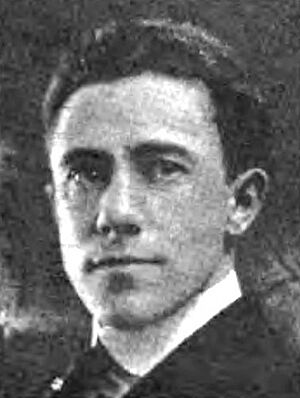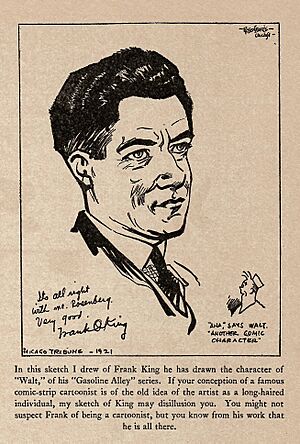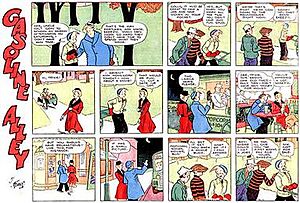Frank King (cartoonist) facts for kids
Quick facts for kids Frank King |
|
|---|---|

King circa 1916
|
|
| Born | Frank Oscar King April 9, 1883 Cashton, Wisconsin, U.S. |
| Died | June 24, 1969 (aged 86) Winter Park, Florida, U.S. |
| Area(s) | Cartoonist |
|
Notable works
|
Gasoline Alley |
Frank Oscar King (born April 9, 1883 – died June 24, 1969) was a famous American cartoonist. He is most known for creating the popular comic strip Gasoline Alley. King was very creative with how he used color and designed his comic pages. He also made his characters grow older over time, which was a new idea for comic strips back then!
Frank was born in Cashton, Wisconsin. He was the older of two sons. When he was four, his family moved to Tomah, Wisconsin. There, his parents ran a general store. Frank started drawing when he was young in Tomah. He finished high school in 1901.
He entered drawing contests at country fairs. Once, he drew a sign for a hotel, earning only 25 cents. But a traveling salesman saw it and helped him get an interview. Frank then got a job at the Minneapolis Times newspaper. He earned $7 a week and later doubled his pay. He also drew pictures in courtrooms.
Contents
Frank King's Early Career
Studying Art in Chicago
In 1905, Frank King went to art school in Chicago. He studied at the Chicago Academy of Fine Arts. After school, he worked for an ad agency. He also worked briefly at the Chicago American newspaper.
Then, he spent three years at the Chicago Examiner. There, he worked alongside another cartoonist, T. S. Sullivant. In 1909, King moved to the Chicago Tribune newspaper. He worked with other talented cartoonists like Clare Briggs.
First Comic Strips
At the Tribune, Frank King started a short daily comic strip. It was called Jonah, a Whale for Trouble. It ran from October to December 1910. He also created a Sunday strip called Young Teddy. This strip appeared from September 1911 to October 1912. Another funny Sunday strip he made was Hi-Hopper, about a frog.
On February 7, 1911, King married Delia Drew. She was also from Tomah. They moved to Chicago and later had a son named Robert in 1916. The family moved to Glencoe, a suburb near Lake Michigan.
The Rectangle and New Ideas
What Was The Rectangle?
The Rectangle was a special page in the Chicago Tribune. It featured many different cartoons and stories. Frank King's Rectangle page usually appeared on Sundays. It was often printed in black and white.
In 1913, King started drawing single-panel cartoons. These were inside a box, or "rectangle." The title The Rectangle was first used in December 1914.
King's Other Comics
King created several comic strips that appeared regularly. These included Tough Teddy and Here Comes Motorcycle Mike. He also drew Hi Hopper (the frog comic). His first successful full-page comic was Bobby Make-Believe. It ran from 1915 to 1919. During World War I, King even drew scenes of the war from overseas.
Creating Gasoline Alley
How the Idea Started
On Sunday, November 24, 1918, a small part of The Rectangle page showed something new. It featured characters named Walter, Bill, Doc, and Avery. They were fixing their cars in the alley behind their homes. This section was called Sunday Morning in Gasoline Alley.
King remembered how he got the idea. He said his brother and friends would talk about cars in the alley. Frank would join them, and that's how Gasoline Alley began. The daily Gasoline Alley comic strip started on August 24, 1919.
Real-Life Inspiration
Frank King often said his wife, Delia, helped him. She gave him ideas for the "woman's angle" in Gasoline Alley. The main character, Walt, was based on King's brother-in-law. King's own son, Robert, was the model for the character Skeezix. Other characters were also inspired by real people King knew.
King hired a young man named Bill Perry as his assistant. He trained Perry to help him with the comic. King liked to keep his Sunday stories simple and friendly. But he also tried new and interesting ways to draw his comics.
Unique Art Styles
For example, on May 24, 1931, King drew a whole page as one big landscape. It looked like a diagram of a neighborhood seen from above. He divided this view into 12 equal panels. Each panel showed a different funny moment.
In 1934, King did something even more amazing. For three weeks in a row, he used the whole page as one image. He showed a house being built, from start to finish. The first page showed Skeezix and his friend playing around the house's foundation.
Success and Legacy
Gasoline Alley became very popular. It was published in over 300 newspapers every day. More than 27 million people read it! The comic strip and its toys made Frank King a very rich man.
In 1929, the King family moved to Florida. They lived on a large estate called Folly Farms. It was near Lake Tohopekaliga. King enjoyed his hobbies there. He sculpted, collected maps, played the fiddle, and grew flowers.
King once wrote about the future of his characters. He imagined Skeezix would marry and have a family. Then Skeezix's children would grow up and have their own kids. This way, the story would continue forever.
Frank King stopped drawing the Sunday strip in 1951. His assistant, Bill Perry, took over. King retired from the daily strip in 1959. His other assistant, Dick Moores, continued it. Gasoline Alley is still being published today!
Frank King passed away on June 24, 1969, in Winter Park, Florida. He was buried next to his wife, Delia.
Awards and Recognition
Exhibitions and Honors
Frank King's artwork was shown in special exhibitions. His drawings are now part of a permanent collection. It is at the Billy Ireland Cartoon Library & Museum. In 1955, he was a special guest at his hometown's celebration in Tomah. He was given an Indian headdress as an honor.
You can see his old desk at the Tomah Area Historical Society Museum. In 1969, signs for Gasoline Alley were put up in Tomah.
King's Highway
There is even a road in Florida named King's Highway. It runs near his old Folly Farms estate. A banker character in Gasoline Alley was based on a real banker named N. Ray Carroll. When Carroll became a state senator, he helped name the road after Frank King.
Frank King was honored twice by the Freedom Foundation. He also received awards three times from the National Cartoonists Society.
- 1949: Silver T-Square Award
- 1957: Humor Comic Strip Award
- 1958: Reuben Award




